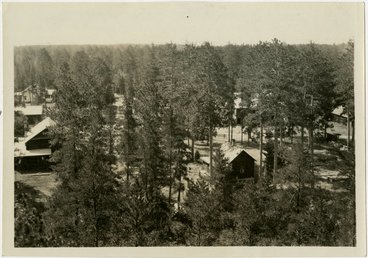The history presented here does not reflect the voices of Fond du Lac or other tribal communities. See our Tribal Relations page for more information.
In the early 1900s, the Cloquet Forestry Center was established primarily through the efforts of five people: Professor Samuel B. Green (head of the University of Minnesota School of Forestry); Fred D. Vibert (state senator and publisher of the Cloquet Pine Knot newspaper); Rudolph and Frederick E. Weyerhaeuser, who were connected to several regional sawmills, railroads, and logging operations, and Henry C. Horby, General Manager of the Cloquet Lumber Company (owned by the Weyerhaeuser family).
The primary intent for establishing a research forest was to develop methods for the reforestation of cut-over lands and the long-term demonstration of silvicultural principles to the public. It was recognized that European models of sustained-yield forest management needed to be brought to Minnesota. As such, they needed a location representative of the forest conditions prevailing in northern Minnesota at which to study the techniques of forestation, influences on the forest, management, mensuration, and silviculture (Kenety 1917) and give forestry students field-based training to supplement their on-campus education.
Green felt a forestry field station should be located relatively near an important sawmill center. He received support from the sawmills in Cloquet, led by the Weyerhaeuser family, for creating a school forest. This support brought together, in 1909, the necessary federal and state legislation—and sufficient funding—to permit the federal government to deed 2,215 acres of unallotted Indian lands on the Fond du Lac Reservation directly to the University of Minnesota.
The initial block of 2,215 acres was paid for by the St. Louis River Mercantile Co. with the understanding that while the title to the land would go to the University of Minnesota, the timber rights would be retained by the company. The St. Louis River Mercantile cut most of the red and white pine on the tract in 1910, under the supervision of the federal Indian Service.
The Northern Lumber Company owned the timber rights on several smaller tracts of land deeded to the University of Minnesota, and at the request of the university, agreed to leave several areas uncut. The uncut wood amounted to 109,310 board feet of white pine, and 1,188,110 board feet of red pine. The lumber companies were reimbursed by the University for the price that was paid to the Reservation for that timber. An additional 447 acres were purchased from Indian allotments, made possible, in part, through the Dawes Act (1887) and Nelson Act (1889), and paid for with funding granted by the State legislature.
The purchase of several more small homestead tracts over the years, and the acquisition of several gifts of land, have increased the Center to its current size of 3391 contiguous acres near Cloquet, MN and 3471 acres total in Carlton County. The Cloquet Forestry Center (Carlton County), the Hubachek Wilderness Research Center (Lake Co.), the Allred Trust (St. Louis Co.), and the Boone Trust (St. Louis Co.) make up the unofficial University of Minnesota Experimental Forests network. These sites are used for natural resources education and research and are administered by the Cloquet Forestry Center’s Director of Operations and Forest Manager
The center has had several name changes since its establishment. In chronological order, it was the Cloquet Forest, Cloquet Forest Experiment Station, Cloquet Experimental Forest, and Cloquet Forest Research Center, before receiving its current name, Cloquet Forestry Center in 1972.




